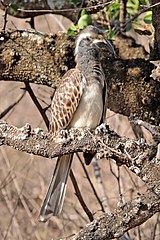African grey hornbill
| African grey hornbill | |
|---|---|

| |
| Male L. n. nasutus in Senegal | |

| |
| Female L. n. epirhinus in Namibia Call of nominate subspecies, Kenya | |
| Scientific classification | |
| Domain: | Eukaryota |
| Kingdom: | Animalia |
| Phylum: | Chordata |
| Class: | Aves |
| Order: | Bucerotiformes |
| Family: | Bucerotidae |
| Genus: | Lophoceros |
| Species: | L. nasutus
|
| Binomial name | |
| Lophoceros nasutus (Linnaeus, 1766)
| |

| |
L. n. nasutus
L. n. epirhinus
| |
| Synonyms | |
| |
The African grey hornbill (Lophoceros nasutus) is a member of the
Taxonomy
In 1760 the French zoologist
The African grey hornbill is now placed in the genus Lophoceros that was introduced in 1833 by two German naturalists, Wilhelm Hemprich and Christian Gottfried Ehrenberg. This genus was resurrected in 2013 to contain a group of hornbills that had previously been placed in the genus Tockus.[7][8] The genus name Lophoceros combines the Ancient Greek lophos meaning "crest" with kerōs meaning "horn". The specific epithet nasutus is from Latin and means "large-nosed".[9]
Two subspecies are recognized:[8]
- L. n. nasutus (Linnaeus, 1766) — Senegal and Gambia to Ethiopia, central Kenya, and southwest Arabia
- L. n. epirhinus (Sundevall, 1850) — south Uganda and south Kenya to northern South Africa
Description

At 45–51 cm (18–20 in) in length, the African grey hornbill is a large bird, although it is one of the smaller
This conspicuous bird advertises its presence with a piping pee-o pee-o pee-o call.
Distribution and habitat
African grey hornbill is widespread over much of sub-Saharan Africa. It prefers open woodland and savannah.
Behaviour and ecology
Breeding
The female lays two to four white eggs in a tree hollow, which is blocked off during incubation with a cement made of mud, droppings and fruit pulp. There is only one narrow aperture, just large enough for the male to transfer food to the mother and the chicks. When the chicks and female outgrow the nest, the mother breaks out and rebuilds the wall, after which both parents feed the chicks.
Food and feeding
The African grey hornbill is omnivorous, taking insects, fruit and reptiles. It feeds mainly in trees.
Gallery
-
L. n. epirhinus, adult male, which has a tubular and forwards-protruding casque[11]
-
L. n. nasutus, adult female at Lake Naivasha, Kenya, with the diagnostic tricoloured bill
References
- . Retrieved 12 November 2021.
- ISBN 9780646221281.
- ^ "Archived copy". Archived from the original on 2018-02-22. Retrieved 2018-02-22.
{{cite web}}: CS1 maint: archived copy as title (link) - ^ Brisson, Mathurin Jacques (1760). Ornithologie, ou, Méthode Contenant la Division des Oiseaux en Ordres, Sections, Genres, Especes & leurs Variétés (in French and Latin). Vol. 4. Paris: Jean-Baptiste Bauche. pp. 573–574, Plate 46 Fig 1. The two stars (**) at the start of the section indicates that Brisson based his description on the examination of a specimen.
- ^ hdl:2246/678.
- ^ Linnaeus, Carl (1766). Systema naturae : per regna tria natura, secundum classes, ordines, genera, species, cum characteribus, differentiis, synonymis, locis (in Latin). Vol. 1, Part 1 (12th ed.). Holmiae (Stockholm): Laurentii Salvii. p. 154.
- ISBN 978-0-9568611-1-5.
- ^ Rasmussen, Pamela, eds. (January 2022). "Mousebirds, Cuckoo Roller, trogons, hoopoes, hornbills". IOC World Bird List Version 12.1. International Ornithologists' Union. Retrieved 10 June 2022.
- ISBN 978-1-4081-2501-4.
- ISBN 978-84-87334-30-6.
- ^ ISBN 0691010226.
External links
- (African) Grey Hornbill species text in The Atlas of Southern African Birds


![L. n. epirhinus, adult male, which has a tubular and forwards-protruding casque[11]](http://upload.wikimedia.org/wikipedia/commons/thumb/8/80/African_Grey_Hornbill_%28Tockus_nasutus%29_male_%2811477408666%29.jpg/333px-African_Grey_Hornbill_%28Tockus_nasutus%29_male_%2811477408666%29.jpg)
![Male of the nominate race in the central Serengeti, with a ridge-like casque[11]](http://upload.wikimedia.org/wikipedia/commons/thumb/6/65/African_Grey_Hornbill_%28Tockus_nasutus%29_-_Flickr_-_Lip_Kee.jpg/300px-African_Grey_Hornbill_%28Tockus_nasutus%29_-_Flickr_-_Lip_Kee.jpg)

